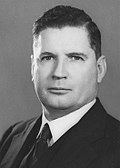Results
House of Representatives
The total for the party forming government after the election is bolded. Parties that have never formed government are listed under "Others".
| Election Year | Prime Minister | Summary | Labor | Free Trade | Protectionist | - | Independent | Other parties | Total seats | |||||
|---|---|---|---|---|---|---|---|---|---|---|---|---|---|---|
| 1st | 1901 | Sir Edmund Barton (1849–1920) | 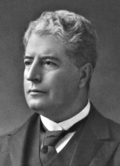 | The Protectionists do not gain a majority, and form a minority government with Labor support, while George Reid's Free Traders form the opposition. | 14 | 28 | 31 | 2 | 75 | |||||
| Election Year | Prime Minister | Summary | Labor | Free Trade | Protectionist | - | Independent | Other parties | Total seats | |||||
| 2nd | 1903 | Alfred Deakin (1856–1919) Chris Watson |  | Protectionist Alfred Deakin forms a minority government with Labor, but the coalition splits over a dispute on the Conciliation and Arbitration Bill. Free Trade leader George Reid declines Government, so the Governor-General commissions Labor leader Chris Watson to form Government. Watson resigns four months later and Free Trade forms Government under Reid, finally passing the Conciliation and Arbitration Act five months later. Labor and the Protectionists return to Government in 1905 when Reid loses the confidence of the parliament. | 23 | 25 | 26 | 1 | Revenue Tariff | 75 | ||||
| Election Year | Prime Minister | Summary | Labor | Anti-Socialist | Protectionist | - | Independent | Other parties | Total seats | |||||
| 3rd | 1906 | Alfred Deakin (1856–1919) Andrew Fisher |  | Protectionist Alfred Deakin forms another minority government, which remains in power largely due to the Anti-Socialists reluctance to pass a vote of no-confidence in it. Deakin loses Labor's support in late 1908 and Andrew Fisher of the Labor Party becomes Prime Minister. Alfred Deakin regains the Prime Ministership as leader of the new Commonwealth Liberal Party. | 26 | 27 | 16 | 1 | 1 | Western Australian | 75 | |||
| Election Year | Prime Minister | Summary | Labor | Commonwealth Liberal | - | - | Independent | Other parties | Total seats | |||||
| 4th | 1910 | Andrew Fisher (1862–1928) |  | Labor wins control of the House of Representatives and the Senate under Andrew Fisher, becoming Australia's first elected federal majority. | 43 | 31 | 1 | 75 | ||||||
| Election Year | Prime Minister | Summary | Labor | Commonwealth Liberal | - | - | Independent | Other parties | Total seats | |||||
| 5th | 1913 | Joseph Cook (1860–1947) |  | The Commonwealth Liberals win a one-seat majority under Joseph Cook while Labor retains control of the Senate. | 37 | 38 | 75 | |||||||
| Election Year | Prime Minister | Summary | Labor | Commonwealth Liberal | - | - | Independent | Other parties | Total seats | |||||
| 6th | 1914 | Andrew Fisher (1862–1928) Billy Hughes |  | Labor forms a government under Andrew Fisher after the double dissolution election, where World War I breaks out in the middle of the campaign. Fisher resigns due to ill-health, and Labor forms government under Billy Hughes. Hughes – a strong advocate of conscription – holds a national plebiscite on conscription to give his stance legitimacy. The plebiscite is defeated. On the 15 September 1916, Hughes is expelled from the Labor party. Hughes briefly forms the National Labor Party and forms Government, but then merges with the Commonwealth Liberal Party to form the Nationalist Party , with Hughes as Prime Minister and Joseph Cook as his deputy. | 42 | 32 | 1 | 75 | ||||||
| Election Year | Prime Minister | Summary | Labor | Nationalist | - | - | Independent | Other parties | Total seats | |||||
| 7th | 1917 | Billy Hughes (1862–1952) |  | The Nationalists form a government under Billy Hughes. A second plebiscite on conscription is held and is defeated again in 1917. | 22 | 53 | 75 | |||||||
| Election Year | Prime Minister | Summary | Labor | Nationalist | Various Agrarian Parties [1] | - | Independent | Other parties | Total seats | |||||
| 8th | 1919 | Billy Hughes (1862–1952) |  | The Nationalists form another government under Billy Hughes with Independent support. First election held under Instant-runoff voting . | 26 | 37 | 11 | 1 | 75 | |||||
| Election Year | Prime Minister | Summary | Labor | Nationalist | Country | - | Independent | Other parties | Total seats | |||||
| 9th | 1922 | Billy Hughes (1862–1952) Stanley Bruce |  | From around 1920, Hughes lost the support of many of the conservative elements of his party. The Nationalists lose their majority in the election. Earle Page declares that his Country Party will not serve under Hughes, forcing Hughes to resign a month after his re-election. His Treasurer Stanley Bruce forms a coalition Government with the Country Party. | 29 | 26 | 14 | 1 | 5 | Liberal | 75 | |||
| Election Year | Prime Minister | Summary | Labor | Nationalist | Country | - | Independent | Other parties | Total seats | |||||
| 10th | 1925 | Stanley Bruce (1883–1967) | 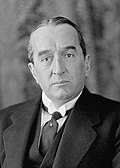 | The Coalition of Nationalists and the Country Party forms another government under Stanley Bruce. | 23 | 37 | 14 | 1 | 75 | |||||
| Election Year | Prime Minister | Summary | Labor | Nationalist | Country | - | Independent | Other parties | Total seats | |||||
| 11th | 1928 | Stanley Bruce (1883–1967) |  | The Coalition forms another government under Stanley Bruce despite Labor gaining eight seats under Jim Scullin. | 31 | 29 | 13 | 1 | 1 | Country Progressives | 75 | |||
| Election Year | Prime Minister | Summary | Labor | Nationalist | Country | - | Independent | Other parties | Total seats | |||||
| 12th | 1929 | Jim Scullin (1876–1953) |  | Labor forms a government under Jim Scullin in an election where Prime Minister Stanley Bruce is defeated in his seat of Flinders. | 46 | 14 | 10 | 4 | 1 | Country Progressives | 75 | |||
| Election Year | Prime Minister | Summary | Labor | United Australia Party | Country | Lang Labor | Independent | Other parties | Total seats | |||||
| 13th | 1931 | Joe Lyons (1879–1939) |  | United Australia , forms a minority government under Joe Lyons. | 14 | 34 | 16 | 4 | 1 | 6 | Emergency Committee | 75 | ||
| Election Year | Prime Minister | Summary | Labor | United Australia Party | Country | Lang Labor | Independent | Other parties | Total seats | |||||
| 14th | 1934 | Joe Lyons (1879–1939) |  | The Coalition of the UAP and the Country Party forms a government under Joe Lyons. | 18 | 28 | 14 | 9 | 5 | LCL | 74 | |||
| Election Year | Prime Minister | Summary | Labor | United Australia Party | Country | Lang Labor | Independent | Other parties | Total seats | |||||
| 15th | 1937 | Joe Lyons (1879–1939) Sir Earle Page Robert Menzies |  | The Coalition forms another government under Joe Lyons. | 29 | 28 | 16 | 1 | 74 | |||||
| Election Year | Prime Minister | Summary | Labor | United Australia Party | Country | Lang Labor | Independent | Other parties | Total seats | |||||
| 16th | 1940 | Robert Menzies (1894–1978) Arthur Fadden John Curtin |  | The Coalition forms a minority government under Robert Menzies. Billy Hughes later replaces him as UAP leader, and Country Party leader Arthur Fadden replaces him as Coalition leader and Prime Minister. Fadden serves for only 40 days, until Labor and the independents defeat his budget. Labor forms Government under John Curtin. | 32 | 23 | 14 | 4 | 1 | 74 | ||||
| Election Year | Prime Minister | Summary | Labor | United Australia Party | Country | Lang Labor | Independent | Other parties | Total seats | |||||
| 17th | 1943 | John Curtin (1885–1945) Frank Forde Ben Chifley |  | Labor forms a government under John Curtin. | 49 | 12 | 8 | 2 | 3 | Country-National, Liberal Country, Country (QLD) | 74 | |||
| Election Year | Prime Minister | Summary | Labor | Liberal | Country | Lang Labor | Independent | Other parties | Total seats | |||||
| 18th | 1946 | Ben Chifley (1885–1951) |  | Labor forms a government under Ben Chifley. | 43 | 15 | 11 | 1 | 1 | 3 | LCL (2), Liberal Country | 74 | ||
| Election Year | Prime Minister | Summary | Labor | Liberal | Country | - | Independent | Other parties | Total seats | |||||
| 19th | 1949 | Robert Menzies (1894–1978) |  | The Coalition forms a government under Robert Menzies, but lacks a Senate majority. Menzies uses the Senate's rejection of the Commonwealth Bank Bill 1951 as a trigger for a double dissolution election. | 47 | 55 | 19 | 121 | ||||||
| Election Year | Prime Minister | Summary | Labor | Liberal | Country | - | Independent | Other parties | Total seats | |||||
| 20th | 1951 | Robert Menzies (1894–1978) |  | The Coalition forms another government under Robert Menzies and gains control of the Senate after a double dissolution. | 52 | 52 | 17 | 121 | ||||||
| Election Year | Prime Minister | Summary | Labor | Liberal | Country | - | Independent | Other parties | Total seats | |||||
| 21st | 1954 | Robert Menzies (1894–1978) |  | The Coalition forms another government under Robert Menzies. | 57 | 47 | 17 | 121 | ||||||
| Election Year | Prime Minister | Summary | Labor | Liberal | Country | - | Independent | Other parties | Total seats | |||||
| 22nd | 1955 | Robert Menzies (1894–1978) |  | The Coalition forms another government under Robert Menzies. | 47 | 57 | 18 | 122 | ||||||
| Election Year | Prime Minister | Summary | Labor | Liberal | Country | - | Independent | Other parties | Total seats | |||||
| 23rd | 1958 | Robert Menzies (1894–1978) |  | The Coalition forms another government under Robert Menzies. | 45 | 58 | 19 | 122 | ||||||
| Election Year | Prime Minister | Summary | Labor | Liberal | Country | - | Independent | Other parties | Total seats | |||||
| 24th | 1961 | Robert Menzies (1894–1978) |  | The Coalition forms another government under Robert Menzies. | 60 | 45 | 17 | 122 | ||||||
| Election Year | Prime Minister | Summary | Labor | Liberal | Country | - | Independent | Other parties | Total seats | |||||
| 25th | 1963 | Sir Robert Menzies (1894–1978) Harold Holt |  | The Coalition forms another government under Sir Robert Menzies. | 50 | 52 | 20 | 122 | ||||||
| Election Year | Prime Minister | Summary | Labor | Liberal | Country | - | Independent | Other parties | Total seats | |||||
| 26th | 1966 | Harold Holt (1908–1967) John McEwen John Gorton |  | The Coalition forms a government under Harold Holt. | 41 | 61 | 21 | 1 | 124 | |||||
| Election Year | Prime Minister | Summary | Labor | Liberal | Country | - | Independent | Other parties | Total seats | |||||
| 27th | 1969 | John Gorton (1911–2002) William McMahon |  | The Coalition forms a government under John Gorton. | 59 | 46 | 20 | 125 | ||||||
| Election Year | Prime Minister | Summary | Labor | Liberal | Country | - | Independent | Other parties | Total seats | |||||
| 28th | 1972 | Gough Whitlam (1916–2014) |  | Labor forms its first government since 1949 under Gough Whitlam. | 67 | 38 | 20 | 125 | ||||||
| Election Year | Prime Minister | Summary | Labor | Liberal | Country | - | Independent | Other parties | Total seats | |||||
| 29th | 1974 | Gough Whitlam (1916–2014) | Labor forms another government under Gough Whitlam after a double dissolution triggered by a hostile Senate and resulting in the 1974 Joint Sitting. | 66 | 40 | 21 | 127 | |||||||
| Election Year | Prime Minister | Summary | Labor | Liberal | National Country Party | - | Independent | Other parties | Total seats | |||||
| 30th | 1975 | Malcolm Fraser (1930–2015) |  | The Coalition forms a government under Malcolm Fraser. | 36 | 68 | 23 | 127 | ||||||
| Election Year | Prime Minister | Summary | Labor | Liberal | National Country Party | - | Independent | Other parties | Total seats | |||||
| 31st | 1977 | Malcolm Fraser (1930–2015) |  | The Coalition forms another government under Malcolm Fraser. | 38 | 67 | 19 | 124 | ||||||
| Election Year | Prime Minister | Summary | Labor | Liberal | National Country Party | - | Independent | Other parties | Total seats | |||||
| 32nd | 1980 | Malcolm Fraser (1930–2015) |  | The Coalition forms another government under Malcolm Fraser. | 51 | 54 | 20 | 125 | ||||||
| Election Year | Prime Minister | Summary | Labor | Liberal | Nationals | - | Independent | Other parties | Total seats | |||||
| 33rd | 1983 | Bob Hawke (1929-2019) | 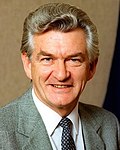 | Labor forms a government under Bob Hawke after a double dissolution. | 75 | 33 | 17 | 125 | ||||||
| Election Year | Prime Minister | Summary | Labor | Liberal | Nationals | - | Independent | Other parties | Total seats | |||||
| 34th | 1984 | Bob Hawke (1929-2019) |  | Labor forms another government under Bob Hawke. | 82 | 45 | 21 | 148 | ||||||
| Election Year | Prime Minister | Summary | Labor | Liberal | Nationals | - | Independent | Other parties | Total seats | |||||
| 35th | 1987 | Bob Hawke (1929-2019) | 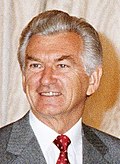 | Labor forms another government under Bob Hawke after a double dissolution over the Australia Card. | 86 | 43 | 19 | 148 | ||||||
| Election Year | Prime Minister | Summary | Labor | Liberal | Nationals | - | Independent | Other parties | Total seats | |||||
| 36th | 1990 | Bob Hawke (1929-2019) Paul Keating |  | Labor forms another government under Bob Hawke. | 78 | 55 | 14 | 1 | 148 | |||||
| Election Year | Prime Minister | Summary | Labor | Liberal | Nationals | - | Independent | Other parties | Total seats | |||||
| 37th | 1993 | Paul Keating (1944– ) |  | Labor forms a government under Paul Keating. | 80 | 49 | 16 | 2 | 147 | |||||
| Election Year | Prime Minister | Summary | Labor | Liberal | Nationals | - | Independent | Other parties | Total seats | |||||
| 38th | 1996 | John Howard (1939– ) |  | The Coalition forms a government under John Howard. | 49 | 75 | 19 | 5 | 148 | |||||
| Election Year | Prime Minister | Summary | Labor | Liberal | Nationals | - | Independent | Other parties | Total seats | |||||
| 39th | 1998 | John Howard (1939– ) |  | The Coalition forms another government under John Howard. | 67 | 64 | 16 | 1 | 148 | |||||
| Election Year | Prime Minister | Summary | Labor | Liberal | Nationals | - | Independent | Other parties | Total seats | |||||
| 40th | 2001 | John Howard (1939– ) |  | The Coalition forms another government under John Howard. | 65 | 69 | 13 | 3 | 150 | |||||
| Election Year | Prime Minister | Summary | Labor | Liberal | Nationals | - | Independent | Other parties | Total seats | |||||
| 41st | 2004 | John Howard (1939– ) |  | The Coalition forms another government under John Howard. | 60 | 75 | 12 | 3 | 150 | |||||
| Election Year | Prime Minister | Summary | Labor | Liberal | Nationals | - | Independent | Other parties | Total seats | |||||
| 42nd | 2007 | Kevin Rudd (1957– ) Julia Gillard |  | Labor forms a government under Kevin Rudd. | 83 | 55 | 10 | 2 | 150 | |||||
| Election Year | Prime Minister | Summary | Labor | Liberal | Nationals | Greens | Independent | Other parties | Total seats | |||||
| 43rd | 2010 | Julia Gillard (1961– ) Kevin Rudd |  | Labor forms a minority government with the support of 3 independents and 1 Green under Julia Gillard. | 72 | 44 (+ 16 LNP and 1 CLP) | 6 + (5 LNP) | 1 | 4 | 1 | WA Nationals | 150 | ||
| Election Year | Prime Minister | Summary | Labor | Liberal | Nationals | Greens | Independent | Other parties | Total seats | |||||
| 44th | 2013 | Tony Abbott (1957– ) Malcolm Turnbull | 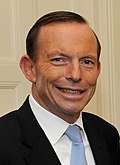 | The Coalition forms a government under Tony Abbott. | 55 | 58 (+ 16 LNP and 1 CLP) | 9 (+6 LNP) | 1 | 2 | 2 | (1) Katter's Australian Party (1) Palmer United | 150 | ||
| Election Year | Prime Minister | Summary | Labor | Liberal | Nationals | Greens | Independent | Other parties | Total seats | |||||
| 45th | 2016 | Malcolm Turnbull (1954– ) (1968– ) |  | The Coalition forms another government under Malcolm Turnbull. | 69 | 45 (+ 15 LNP) | 10 (+ 6 LNP) | 1 | 2 | 2 | (1) Katter's Australian Party (1) Nick Xenophon Team | 150 | ||
| Election Year | Prime Minister | Summary | Labor | Liberal | Nationals | Greens | Independent | Other parties | Total seats | |||||
| 46th | 2019 | Scott Morrison (1968–) |  | The Coalition forms another government under Scott Morrison. | 68 | 44 (+ 17 LNP) | 10 (+ 6 LNP) | 1 | 3 | 2 | (1) Katter's Australian Party (1) Centre Alliance | 151 | ||
| Election Year | Prime Minister | Summary | Labor | Liberal | Nationals | Greens | Independent | Other parties | Total seats | |||||
| 47th | 2022 | Anthony Albanese (1963–) |  | Labor forms a government under Anthony Albanese. | 77 | 27 (+ 15 LNP) | 10 (+ 6 LNP) | 4 | 10 | 2 | (1) Katter's Australian Party (1) Centre Alliance | 151 | ||
| Election Year | Prime Minister | Summary | Labor | Liberal | Nationals | Greens | Independent | Other parties | Total seats | |||||
| 48th | 2025 | Anthony Albanese (1963–) |  | Labor forms another government under Anthony Albanese. | 94 | 18 (+ 10 LNP) | 9 (+ 6 LNP) | 1 | 9 | 2 | (1) Katter's Australian Party (1) Centre Alliance | 150 | ||
House of Representatives primary, two-party and seat results
A two-party system has existed in the Australian House of Representatives since the two non-Labor parties merged in 1909. The 1910 election was the first to elect a majority government, with the Australian Labor Party concurrently winning the first Senate majority. Prior to 1909 a three-party system existed in the chamber. A two-party-preferred vote (2PP) has been calculated since the 1919 change from first-past-the-post to preferential voting and subsequent introduction of the Coalition. ALP = Australian Labor Party, L+NP = grouping of Liberal/National/LNP/CLP Coalition parties (and predecessors), Oth = other parties and independents.
| Election Year | Labor | Free Trade | Protectionist | Independent | Other parties | Total seats | ||||
|---|---|---|---|---|---|---|---|---|---|---|
| 1st | 1901 | 14 | 28 | 31 | 2 | 75 | ||||
| Election Year | Labor | Free Trade | Protectionist | Independent | Other parties | Total seats | ||||
| 2nd | 1903 | 23 | 25 | 26 | 1 | Revenue Tariff | 75 | |||
| Election Year | Labor | Anti-Socialist | Protectionist | Independent | Other parties | Total seats | ||||
| 3rd | 1906 | 26 | 26 | 21 | 1 | 1 | Western Australian | 75 | ||
| Primary vote | 2PP vote | Seats | |||||||
|---|---|---|---|---|---|---|---|---|---|
| ALP | L+NP | Oth. | ALP | L+NP | ALP | L+NP | Oth. | Total | |
| 13 April 1910 election | 50.0% | 45.1% | 4.9% | – | – | 42 | 31 | 2 | 75 |
| 31 May 1913 election | 48.5% | 48.9% | 2.6% | – | – | 37 | 38 | 0 | 75 |
| 5 September 1914 election | 50.9% | 47.2% | 1.9% | – | – | 42 | 32 | 1 | 75 |
| 5 May 1917 election | 43.9% | 54.2% | 1.9% | – | – | 22 | 53 | 0 | 75 |
| 13 December 1919 election | 42.5% | 54.3% | 3.2% | 45.9% | 54.1% | 26 | 48 | 1 | 75 |
| 16 December 1922 election | 42.3% | 47.8% | 9.9% | 48.8% | 51.2% | 29 | 40 | 6 | 75 |
| 14 November 1925 election | 45.0% | 53.2% | 1.8% | 46.2% | 53.8% | 23 | 50 | 2 | 75 |
| 17 November 1928 election | 44.6% | 49.6% | 5.8% | 48.4% | 51.6% | 31 | 42 | 2 | 75 |
| 12 October 1929 election | 48.8% | 44.2% | 7.0% | 56.7% | 43.3% | 46 | 24 | 5 | 75 |
| 19 December 1931 election | 27.1% | 48.4% | 24.5% | 41.5% | 58.5% | 14 | 50 | 11 | 75 |
| 15 September 1934 election | 26.8% | 45.6% | 27.6% | 46.5% | 53.5% | 18 | 42 | 14 | 74 |
| 23 October 1937 election | 43.2% | 49.3% | 7.5% | 49.4% | 50.6% | 29 | 43 | 2 | 74 |
| 21 September 1940 election | 40.2% | 43.9% | 15.9% | 50.3% | 49.7% | 32 | 36 | 6 | 74 |
| 21 August 1943 election | 49.9% | 31.3% | 18.6% | 58.2% | 41.8% | 49 | 23 | 2 | 74 |
| 28 September 1946 election | 49.7% | 39.3% | 11.0% | 54.1% | 45.9% | 43 | 26 | 5 | 74 |
| 10 December 1949 election | 46.0% | 50.3% | 3.7% | 49.0% | 51.0% | 47 | 74 | 0 | 121 |
| 28 April 1951 election | 47.6% | 50.3% | 2.1% | 49.3% | 50.7% | 52 | 69 | 0 | 121 |
| 29 May 1954 election | 50.0% | 46.8% | 3.2% | 50.7% | 49.3% | 57 | 64 | 0 | 121 |
| 10 December 1955 election | 44.6% | 47.6% | 7.8% | 45.8% | 54.2% | 47 | 75 | 0 | 122 |
| 22 November 1958 election | 42.8% | 46.6% | 10.6% | 45.9% | 54.1% | 45 | 77 | 0 | 122 |
| 9 December 1961 election | 47.9% | 42.1% | 10.0% | 50.5% | 49.5% | 60 | 62 | 0 | 122 |
| 30 November 1963 election | 45.5% | 46.0% | 8.5% | 47.4% | 52.6% | 50 | 72 | 0 | 122 |
| 26 November 1966 election | 40.0% | 50.0% | 10.0% | 43.1% | 56.9% | 41 | 82 | 1 | 124 |
| 25 October 1969 election | 47.0% | 43.3% | 9.7% | 50.2% | 49.8% | 59 | 66 | 0 | 125 |
| 2 December 1972 election | 49.6% | 41.5% | 8.9% | 52.7% | 47.3% | 67 | 58 | 0 | 125 |
| 18 May 1974 election | 49.3% | 44.9% | 5.8% | 51.7% | 48.3% | 66 | 61 | 0 | 127 |
| 13 December 1975 election | 42.8% | 53.1% | 4.1% | 44.3% | 55.7% | 36 | 91 | 0 | 127 |
| 10 December 1977 election | 39.7% | 48.1% | 12.2% | 45.4% | 54.6% | 38 | 86 | 0 | 124 |
| 18 October 1980 election | 45.2% | 46.3% | 8.5% | 49.6% | 50.4% | 51 | 74 | 0 | 125 |
| 5 March 1983 election | 49.5% | 43.6% | 6.9% | 53.2% | 46.8% | 75 | 50 | 0 | 125 |
| 1 December 1984 election | 47.6% | 45.0% | 7.4% | 51.8% | 48.2% | 82 | 66 | 0 | 148 |
| 11 July 1987 election | 45.8% | 46.1% | 8.1% | 50.8% | 49.2% | 86 | 62 | 0 | 148 |
| 24 March 1990 election | 39.4% | 43.5% | 17.1% | 49.9% | 50.1% | 78 | 69 | 1 | 148 |
| 13 March 1993 election | 44.9% | 44.3% | 10.7% | 51.4% | 48.6% | 80 | 65 | 2 | 147 |
| 2 March 1996 election | 38.7% | 47.3% | 14.0% | 46.4% | 53.6% | 49 | 94 | 5 | 148 |
| 3 October 1998 election | 40.1% | 39.5% | 20.4% | 51.0% | 49.0% | 67 | 80 | 1 | 148 |
| 10 November 2001 election | 37.8% | 43.0% | 19.2% | 49.0% | 51.0% | 65 | 82 | 3 | 150 |
| 9 October 2004 election | 37.6% | 46.7% | 15.7% | 47.3% | 52.7% | 60 | 87 | 3 | 150 |
| 24 November 2007 election | 43.4% | 42.1% | 14.5% | 52.7% | 47.3% | 83 | 65 | 2 | 150 |
| 21 August 2010 election | 38.0% | 43.3% | 18.7% | 50.1% | 49.9% | 72 | 72 | 6 | 150 |
| 7 September 2013 election | 33.4% | 45.6% | 21.0% | 46.5% | 53.5% | 55 | 90 | 5 | 150 |
| 2 July 2016 election | 34.7% | 42.0% | 23.3% | 49.6% | 50.4% | 69 | 76 | 5 | 150 |
| 18 May 2019 election | 33.3% | 41.4% | 25.3% | 48.5% | 51.5% | 68 | 77 | 6 | 151 |
| 21 May 2022 election | 32.6% | 35.7% | 31.7% | 52.1% | 47.9% | 77 | 58 | 16 | 151 |
| 3 May 2025 election | 34.6% | 31.8% | 33.6% | 55.3% | 44.7% | 94 | 43 | 13 | 150 |






